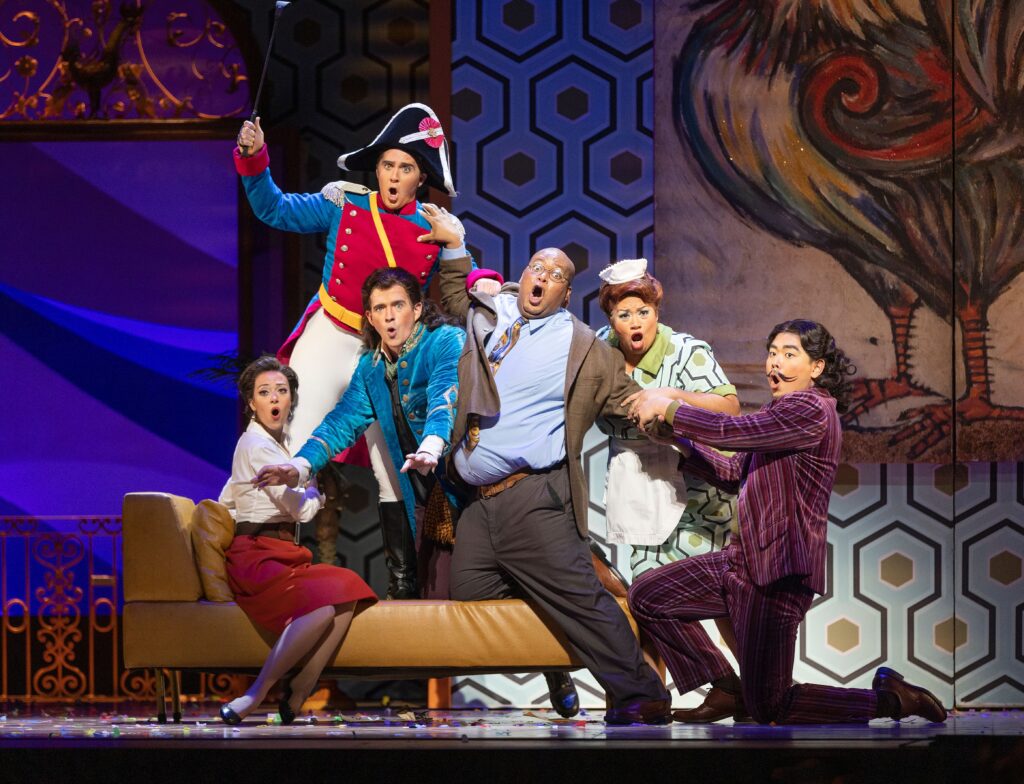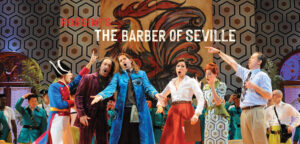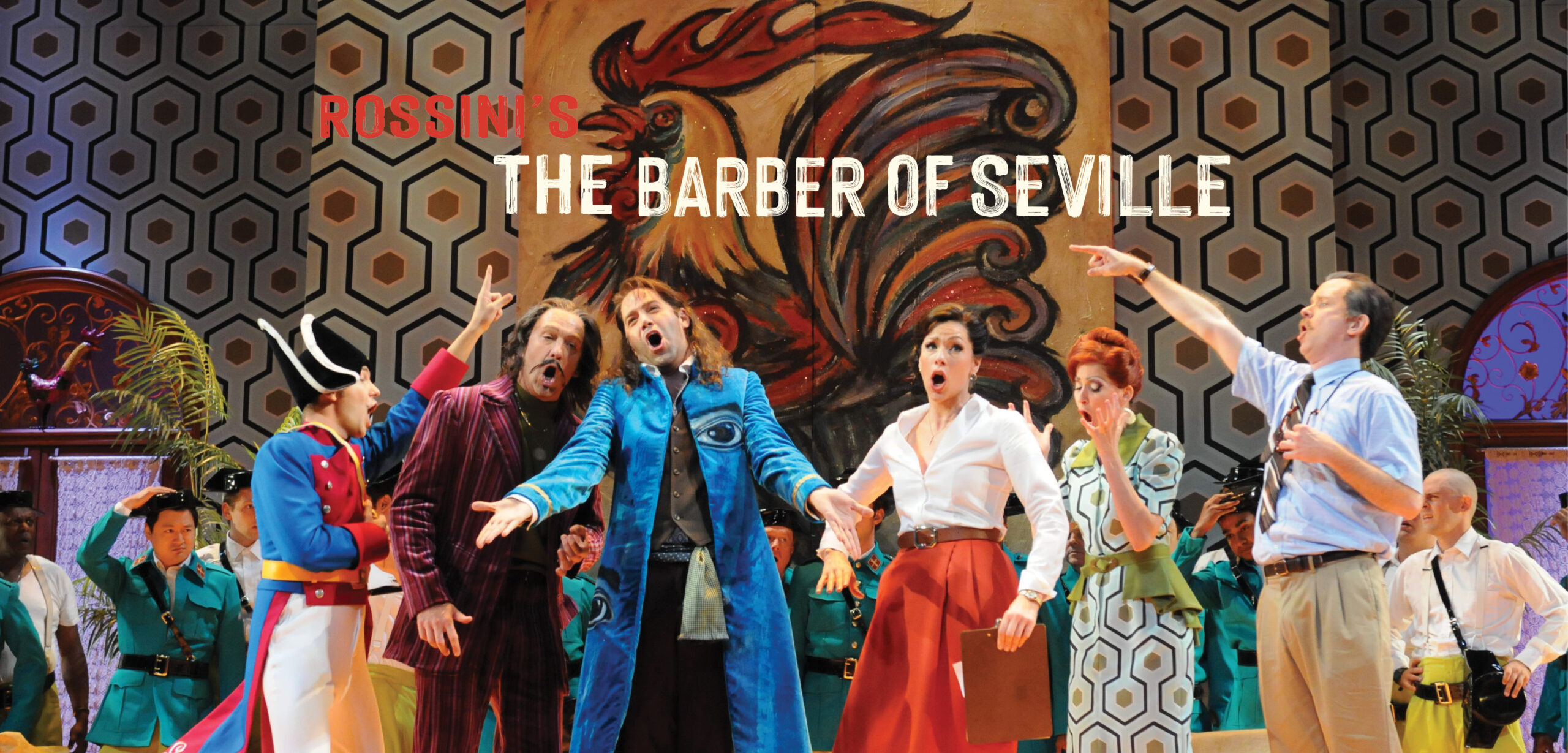While hearing rarely-performed operas is always a treat, watching a famous opera is akin to comfort food. Austin Opera is serving up heaps of comfort food this week with two more performances of The Barber of Seville by Rossini, an old chestnut from 1816.
It is in the Bel canto opera style, which literally means the beautiful singing voice style. Trills are mixed liberally with recitative in an often rapid style that delights as much as it astonishes. This version of the Barber is a sheer delight, being inspired by the films of Pedro Almodóvar. Director Michael Shell took his brilliance at “walking the line between dramatic comedy and melodramatic absurdity” to heart, literally translating this filmic experience to the staging of Rossini’s masterpiece.
“We also bring Almodóvar’s sensibility towards his characters in terms of gender and sexuality,” writes Shell. This is especially expressed by the lead soprano role. In 1958 Maria Callas famously performed Rosina; the role is sung here by Austin-born Lauren Snouffer, who brings the perfect pitch of coquettishness to the role that Shell has directed. Overall, the effect of the inspiration from the Spanish film maker (now 73 years old) is to make The Barber of Seville a fresh experience.
The background to this opera is explained by Dr Charles Carson, Professor of Musicology at the University of Texas in Austin.
“Many people consider Rossini to be the heir to the Italian opera tradition set up by Mozart. Rossini effectively ruled opera until the grand opera tradition started pushing out the bel canto opera.” But Rossini had competition. “Giovanni Paisiello had already written another setting of The Barber of Seville which was very popular. To have this young, upstart composer Rossini write another setting of this seemed like a slight to Paisello.”
Supporters of Paisello were in the audience for the first performance to boo; and the performance was interrupted by a cat that wandered on stage. Despite the poor premiere, Rossini wrote to his Mother afterwards: “I wrote to you that my opera was booed. Now I can write that on the second evening and all the following performances they cheered this work of mine with indescribable fanaticism for which I came five or six times to receive applause of a totally new kind, and that made me cry with pleasure.” Of all the 39 operas he composed (30 of them in the decade from 1812-1822), Rossini hit his peak with this one.
“It’s based on a series of plays by the French playwright Pierre Beamarchais,” Carson said. “He wrote 3 chapters of this story. This is actually the first. The Barber of Seville is followed by The Marriage of Figaro (famously set by Mozart) and The Guilty Mother, which isn’t really in the opera repertoire.”

Early in the opera is one of the great fan favourite arias in all of opera: Largo al factotum (see more on this below). “Figaro is a factotum – he facilitates many things, including hair, teeth and medical things. But most importantly for the opera he helps with matchmaking and other intrigue. We learn who he is through this entrance aria where he describes all the people who come to him and want pieces of him all the time. It’s a virtuosic display of singing, and it’s so much fun every time you hear it, it’s like the first time.” In the role of Figaro is Emmett O’Hanlon. His take on Figaro is a bit twisted, sort of like Johnny Depp as a pirate, and he performs the aria with the same dash of comedic genius. The fireworks between him and Snouffer make this more than just a pairing of a soprano and a baritone; the electricity is palpable.
This is an absurdly funny production. Near the outset we see a large fellow holding 2 cymbals, clearly dying to bang them together. He is dissuaded from doing so and eventually leaves the stage, only to dash back on to make big noise. Just the sort of thing Ralph Kramden would do in The Honeymooners. The mezzo-soprano Claudia Chapa, in her role as a servant, nearly steals the show with her antics in this opera turned farce turned parody. Capping it all are the Keystone Cops; that, at least, is what the police force looks like. Jack Swanson as Count Almavira is an expert at singing the acrobatic arias of Rossini, and of course everyone roots for such a handsome man winning the affections of Rosina. His role is especially enhanced by the outrageous garbs he dons throughout the opera; kudos to costume designer Amanda Seymour. The bass-baritone Musa Ngqungwana plays Bartolo with all the bumbling affection the role demands. Great casting!
An ode to love and faith (Amor e fede) suitably serves as the rousing finale to this inspired production, with music under the baton of Stephanie Rhodes Russell, an alumna of the Dallas Opera’s Institute for Women Conductors.
Addendum on the Figaro aria, written by Conlan Salgado:
What’s particularly fun about this Rossini masterpiece is how the music both compliments and improves upon the rather ridiculous libretto. The music is comically constructed; the case in point is Largo al Factotum. The music skitters, hops about, runs up and down, squeals—its funniness, like much of the acting, is physical. The lyrics run, at one point, as follows:
Ready to do everything,
day and night
he’s always going here and there.
A barber who has more fun,
a more noble life, no, doesn’t exist
Razors and combs
lancets and scissors,
at my command
I’ve got everything here
Here are the tools,
then, of the trade
with the little lady… with the knight…
Everybody asks for me, everybody wants me,
ladies, boys, the elderly, maidens:
Here a wig… there a shave…
Here a leech…
There a ticket….
Here a wig, there a shave,
Then the ticket, ehi!
“Here a wig/there a shave?” Could we take the words seriously without Rossini’s magnificent score lending it credibility?
Visit AustinOpera.org for tickets to future performances: Nov. 10 and 13, 2022.

